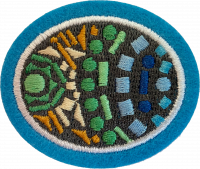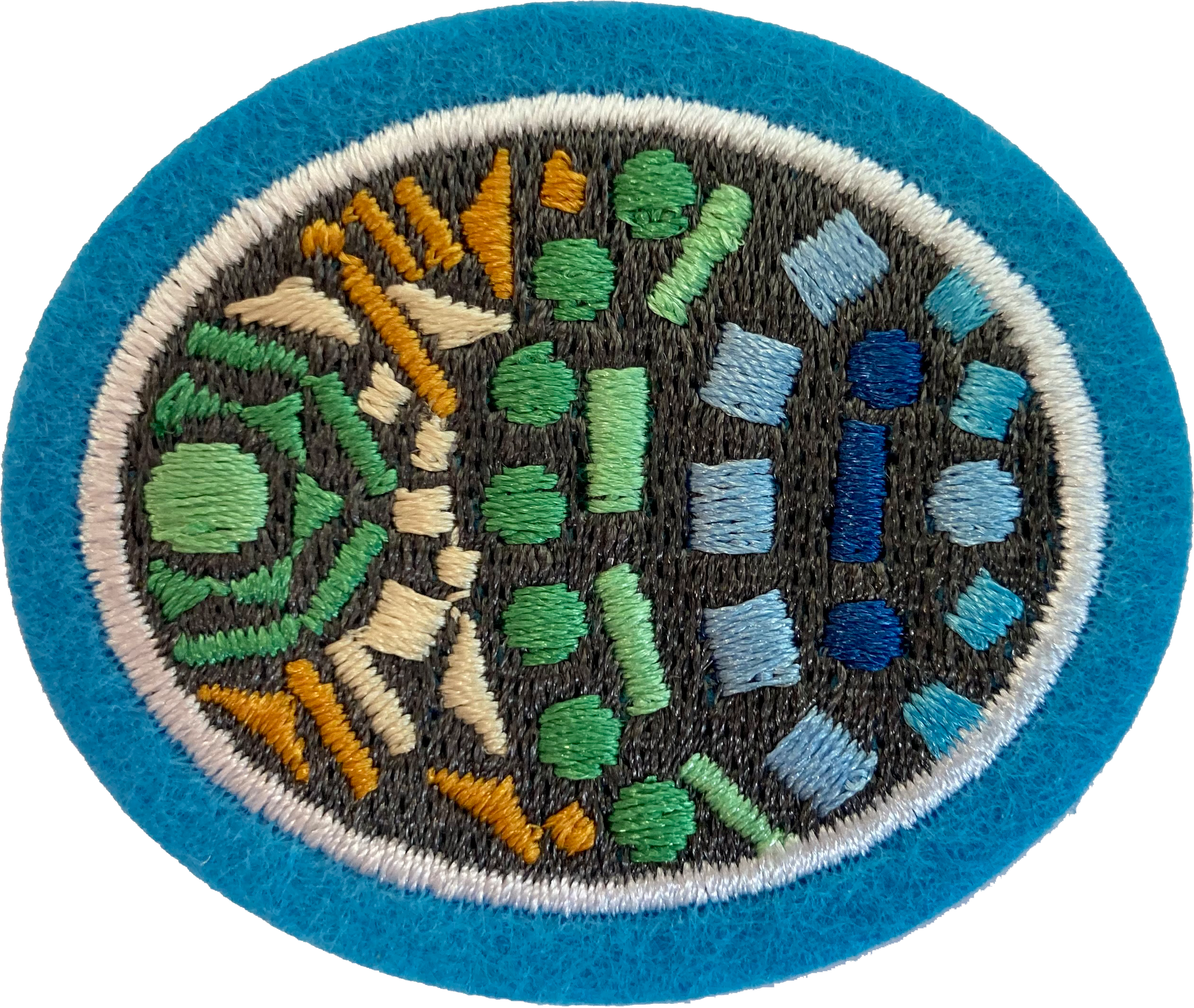|
|
| (25 intermediate revisions by 2 users not shown) |
| Line 1: |
Line 1: |
| − | <languages /><br />
| + | {{HonorSubpage}} |
| − | <noinclude></noinclude>
| |
| − | | |
| − | {{honor_desc/es | |
| − | |stage=00
| |
| − | |honorname=Azulejos de mosaico
| |
| − | |skill=1
| |
| − | |year=2020
| |
| − | |category=Artes y actividades manuales
| |
| − | |authority=División Norteamericana
| |
| − | |insignia=Parche No Disponible.png
| |
| − | }} | |
| − | | |
| − | | |
| − | <noinclude></noinclude>
| |
| | <section begin="Body" /> | | <section begin="Body" /> |
| | {{ansreq|page={{#titleparts:{{PAGENAME}}|2|1}}|num=1}} | | {{ansreq|page={{#titleparts:{{PAGENAME}}|2|1}}|num=1}} |
| Line 41: |
Line 27: |
| | {{ansreq|page={{#titleparts:{{PAGENAME}}|2|1}}|num=2}} | | {{ansreq|page={{#titleparts:{{PAGENAME}}|2|1}}|num=2}} |
| | <noinclude></noinclude> | | <noinclude></noinclude> |
| − | <!-- 2. What type of material is tile commonly made of? --> | + | <!-- 2. ¿De qué tipo de material está hecho comúnmente los azulejos? --> |
| | | | |
| − | Ceramic, Stone such as Granite, Marble, Quartzite, glass
| + | {{clear}} |
| | | | |
| | <noinclude></noinclude> | | <noinclude></noinclude> |
| Line 49: |
Line 35: |
| | {{ansreq|page={{#titleparts:{{PAGENAME}}|2|1}}|num=3}} | | {{ansreq|page={{#titleparts:{{PAGENAME}}|2|1}}|num=3}} |
| | <noinclude></noinclude> | | <noinclude></noinclude> |
| − | <!-- 3. What is the difference between glazed and unglazed tile? --> | + | <!-- 3. ¿Cuál es la diferencia entre los azulejos esmaltados y no esmaltados? --> |
| | | | |
| − | In terms of how they are manufactured, there is no difference between glazed and unglazed ceramic and porcelain tile, other than the fact that glazed tiles undergo an additional phase in the firing process. During this additional process, a layer of liquid glass is added to glazed tiles by means of very high temperatures.
| + | {{clear}} |
| | | | |
| − | Unglazed tiles tend to be denser and thicker than glazed tiles, and because of their unfinished exteriors, they tend to be a great choice if you’re looking for a slip resistant surface in an area like a laundry room or kitchen where the tile is likely to be subjected to high amounts of moisture. In terms of safety, this is a big consideration. For areas with heavy foot traffic, as well as outdoor applications (in milder climates), unglazed tiles are a very good choice.
| + | {{clear}} |
| | | | |
| − | Along with safety benefits, unglazed ceramic and porcelain tiles are sought after because of their scratch resistance and natural beauty. Since they’re colored by the mineral deposits from where the clay was originally taken, these tiles offer an earthy aesthetic quality. A limitation of unglazed ceramic and porcelain is their vulnerability to staining. As a precaution, it’s a good idea to use a sealant and wax after installing unglazed ceramic tile indoors.
| + | {{clear}} |
| | | | |
| − | Although glazed ceramic and porcelain tile are a little less robust in terms of density and thickness than their unglazed counterpart, they allow for a wider range of styles and colors. Glazed tiles also tend to be more resistant to staining, as they’re protected by a non-porous layer of liquid glass.
| + | {{clear}} |
| | | | |
| − | Whether you choose glazed or unglazed tile, both types have their own unique qualities. As always, it’s best to know the needs of your space and the look you are after. This way, your flooring project will be something you can enjoy for many years in the future.
| + | {{clear}} |
| | | | |
| | <noinclude></noinclude> | | <noinclude></noinclude> |
| Line 65: |
Line 51: |
| | {{ansreq|page={{#titleparts:{{PAGENAME}}|2|1}}|num=4}} | | {{ansreq|page={{#titleparts:{{PAGENAME}}|2|1}}|num=4}} |
| | <noinclude></noinclude> | | <noinclude></noinclude> |
| − | <!-- 4. What is the difference between sanded and unsanded grout? In what applications is each type used? --> | + | <!-- 4. ¿Cuál es la diferencia entre la lechada con y sin arena? ¿En qué aplicaciones se usa cada tipo? --> |
| | | | |
| − | Tile grout acts like a mortar that binds the tiles together, but it also keeps moisture out and helps ensure the tiles stay a certain distance apart. A variety of grouts are available commercially, but all of these can be classified as one of two basic types: sanded or unsanded. The right choice for your tile depends on the type of tiles you’re installing and the size of the joint between them.
| + | {{clear}} |
| | | | |
| − | The main difference between unsanded and sanded grout is the presence or absence of sand. Unsanded cement-based grout is a smooth mixture of Portland cement, powdered pigments and water. Epoxy grouts are made of resin and hardener. Sanded cement-based grout and sanded epoxy grouts are basically the same as the previously mentioned mixtures but with sand added. The sand thickens the grout to prevent shrinking in the joints.
| + | {{clear}} |
| | | | |
| − | Both cement-based grouts and epoxy grouts come in sanded and unsanded types and can both be used with floor and wall tiles. Cement-based grouts are traditionally used in residential applications. Epoxy grouts are more ideal for situations where the tiles will be exposed to harsh materials, such as acids and greases.
| + | {{clear}} |
| | | | |
| − | Unsanded grout should be used in joints that are less than 1/8-inch-wide. It has a smooth texture and clings well to vertical surfaces, which makes it useful for grouting ceramic wall tiles. Sanded grout should be used for flooring and wall tile joints wider than 1/8 inch because it resists shrinkage and cracking. It is possible to use sanded grout in thinner joints, but forcing the bulky mixture into these joints is difficult, and pinholes may occur in your finished grout lines. Joints larger than 3/8 inch need heavily-sanded grout mixture, which is typically labeled as a wide-joint mixture and is available at most hardware and flooring stores.
| + | {{clear}} |
| | | | |
| − | The size of the tile joint usually dictates which type of grout to use, but sometimes the type of tile is the deciding factor. For example, unsanded grout is recommended for highly polished, easily scratched tiles such as marble because the aggregate in sanded grouts may damage these types of tiles. Unsanded grout should not be used in floor tiles, however, because the grout can crack and break under the pressure of floor traffic.
| + | {{clear}} |
| | | | |
| | <noinclude></noinclude> | | <noinclude></noinclude> |
| Line 81: |
Line 67: |
| | {{ansreq|page={{#titleparts:{{PAGENAME}}|2|1}}|num=5}} | | {{ansreq|page={{#titleparts:{{PAGENAME}}|2|1}}|num=5}} |
| | <noinclude></noinclude> | | <noinclude></noinclude> |
| − | <!-- 5. List three tools commonly used for tile installation. --> | + | <!-- 5. Nombrar tres herramientas comúnmente utilizadas para la instalación de azulejos. --> |
| | | | |
| − | * Tile Cutter
| + | {{clear}} |
| − | * Diamond Drill Bit
| |
| − | * Tile Mortar Mixer
| |
| − | * Buckets
| |
| − | * Tile Trowel
| |
| − | * Rubber Grout Float
| |
| − | * Tile Spacers
| |
| − | * Sponge
| |
| − | * Knee Pads
| |
| − | * Level
| |
| − | * Tape Measure
| |
| | | | |
| | <noinclude></noinclude> | | <noinclude></noinclude> |
| Line 99: |
Line 75: |
| | {{ansreq|page={{#titleparts:{{PAGENAME}}|2|1}}|num=6}} | | {{ansreq|page={{#titleparts:{{PAGENAME}}|2|1}}|num=6}} |
| | <noinclude></noinclude> | | <noinclude></noinclude> |
| − | <!-- 6. Do the following: --> | + | <!-- 6. Realizar las siguientes actividades: --> |
| | | | |
| | <noinclude></noinclude> | | <noinclude></noinclude> |
| Line 119: |
Line 95: |
| | {{ansreq|page={{#titleparts:{{PAGENAME}}|2|1}}|num=7}} | | {{ansreq|page={{#titleparts:{{PAGENAME}}|2|1}}|num=7}} |
| | <noinclude></noinclude> | | <noinclude></noinclude> |
| − | <!-- 7. Describe how to properly apply grout. --> | + | <!-- 7. Describir cómo aplicar correctamente la lechada. --> |
| | | | |
| − | Good grout makes for a great tile job and here is the best way to apply grout. After the grout is totally mixed, apply a generous amount to the tile surface and use a foam tile float to distribute it completely filling the tile joints all the way to the bottom by pressing firmly. Once the joints are filled, hold the float at a steep angle and begin removing excess grout from the face of the tile. Always move in a diagonal direction. If you don’t, you run the risk of scooping out grout from the joints you just filled. Dip a cellulose grout sponge in water and wring out most but not all of the water. Then wash the face of the tiles, being careful not to pull the grout out of the joints. Cutting the sponge in half on a tile saw creates a nice square edge that’s ideal for getting into corners. For a final rinsing, dip the sponge in clean water and wring it out thoroughly. Then tip the sponge up so that only the leading edge is touching the tile. Move diagonally across the surface with straight overlapping strokes. Every couple of strokes, flip the sponge around and use one of the remaining clean edges.
| + | {{clear}} |
| | | | |
| | <noinclude></noinclude> | | <noinclude></noinclude> |
| Line 127: |
Line 103: |
| | {{ansreq|page={{#titleparts:{{PAGENAME}}|2|1}}|num=8}} | | {{ansreq|page={{#titleparts:{{PAGENAME}}|2|1}}|num=8}} |
| | <noinclude></noinclude> | | <noinclude></noinclude> |
| − | <!-- 8. Describe how to properly seal and finish a tile project. --> | + | <!-- 8. Describir cómo sellar adecuadamente y terminar un proyecto de mosaico. --> |
| | | | |
| | <noinclude></noinclude> | | <noinclude></noinclude> |
| Line 133: |
Line 109: |
| | {{ansreq|page={{#titleparts:{{PAGENAME}}|2|1}}|num=9}} | | {{ansreq|page={{#titleparts:{{PAGENAME}}|2|1}}|num=9}} |
| | <noinclude></noinclude> | | <noinclude></noinclude> |
| − | <!-- 9. Complete a tile project such as a trivet, potholder, or other household items. The item should be at least 6” x 6” (15.25 cm x 15.25 cm). --> | + | <!-- 9. Completar un proyecto de mosaico como un salvamanteles, agarraderas de cocina u otros artículos domésticos. El artículo debe ser de por lo menos 6” por 6” (15.25 cm por 15.25 cm). --> |
| | | | |
| | <noinclude></noinclude> | | <noinclude></noinclude> |
| | {{CloseReq}} <!-- 9 --> | | {{CloseReq}} <!-- 9 --> |
| − | <noinclude><div class="mw-translate-fuzzy">
| |
| − | </noinclude>
| |
| − | ==Referencias==
| |
| − | </div>
| |
| − |
| |
| − | [[Category:Adventist Youth Honors Answer Book/es]]
| |
| | <noinclude></noinclude> | | <noinclude></noinclude> |
| − | <section end="Body" /> | + | ==Referencias==</noinclude> |
| | + | {{CloseHonorPage}} |


